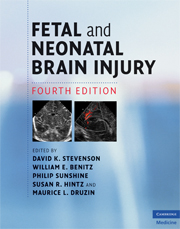Book contents
- Frontmatter
- Contents
- List of contributors
- Foreword
- Preface
- Section 1 Epidemiology, pathophysiology, and pathogenesis of fetal and neonatal brain injury
- Section 2 Pregnancy, labor, and delivery complications causing brain injury
- 5 Prematurity and complications of labor and delivery
- 6 Risks and complications of multiple gestations
- 7 Intrauterine growth restriction
- 8 Maternal diseases that affect fetal development
- 9 Obstetrical conditions and practices that affect the fetus and newborn
- 10 Fetal and neonatal injury as a consequence of maternal substance abuse
- 11 Hypertensive disorders of pregnancy
- 12 Complications of labor and delivery
- 13 Fetal response to asphyxia
- 14 Antepartum evaluation of fetal well-being
- 15 Intrapartum evaluation of the fetus
- Section 3 Diagnosis of the infant with brain injury
- Section 4 Specific conditions associated with fetal and neonatal brain injury
- Section 5 Management of the depressed or neurologically dysfunctional neonate
- Section 6 Assessing outcome of the brain-injured infant
- Index
- Plate section
- References
7 - Intrauterine growth restriction
from Section 2 - Pregnancy, labor, and delivery complications causing brain injury
Published online by Cambridge University Press: 12 January 2010
- Frontmatter
- Contents
- List of contributors
- Foreword
- Preface
- Section 1 Epidemiology, pathophysiology, and pathogenesis of fetal and neonatal brain injury
- Section 2 Pregnancy, labor, and delivery complications causing brain injury
- 5 Prematurity and complications of labor and delivery
- 6 Risks and complications of multiple gestations
- 7 Intrauterine growth restriction
- 8 Maternal diseases that affect fetal development
- 9 Obstetrical conditions and practices that affect the fetus and newborn
- 10 Fetal and neonatal injury as a consequence of maternal substance abuse
- 11 Hypertensive disorders of pregnancy
- 12 Complications of labor and delivery
- 13 Fetal response to asphyxia
- 14 Antepartum evaluation of fetal well-being
- 15 Intrapartum evaluation of the fetus
- Section 3 Diagnosis of the infant with brain injury
- Section 4 Specific conditions associated with fetal and neonatal brain injury
- Section 5 Management of the depressed or neurologically dysfunctional neonate
- Section 6 Assessing outcome of the brain-injured infant
- Index
- Plate section
- References
Summary
Introduction
Fetuses that grow at rates less than their inherent growth potential have intrauterine growth restriction or IUGR. Such infants, particularly when the IUGR is severe, tend to have significant problems later in life, with structural and functional neurodevelopmental disorders. Animal models confirm that decreased brain neuronal number and dendritic arborization, cognitive capacity, and behavioral function are common when growth at critical early stages of development is restricted. Understanding the basic problems that contribute to IUGR and the characteristics of such infants, therefore, is important to complement other discussions in this textbook about fetal and neonatal brain injury.
Terminology and definitions
IUGR refers to a slower than normal rate of fetal growth. Several terms have been used, often interchangeably, for IUGR. These include fetal growth retardation, fetal mal- or undernutrition, small for gestational age (SGA), small or light for dates, dysmature, placental insufficiency syndrome, “runting” syndrome, and hypotrophy. The term “restriction” is preferred to “retardation,” because parents tend to link “retardation” with mental retardation. Unfortunately, these terms do not all mean the same, which has led to some confusion, both with regard to etiologic classification and to follow-up and outcome. In interpreting studies dealing with IUGR, it is important to know how the term has been defined for the particular study. Most importantly, birthweight does not always determine fetal growth rate. See Table 7.1 for a classification schema of fetal growth that now is standard.
- Type
- Chapter
- Information
- Fetal and Neonatal Brain Injury , pp. 75 - 95Publisher: Cambridge University PressPrint publication year: 2009



